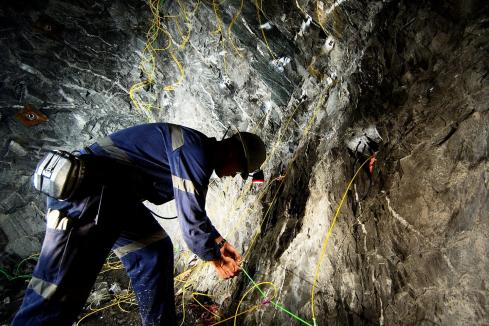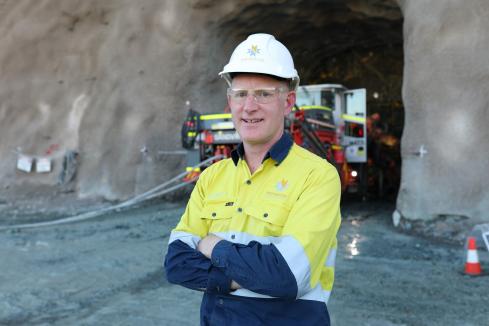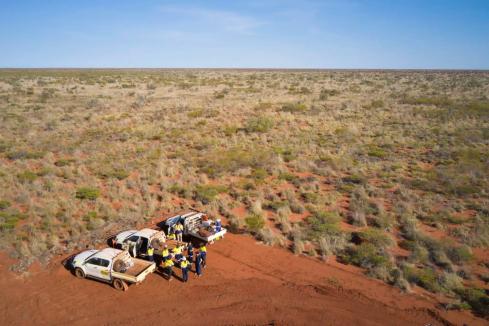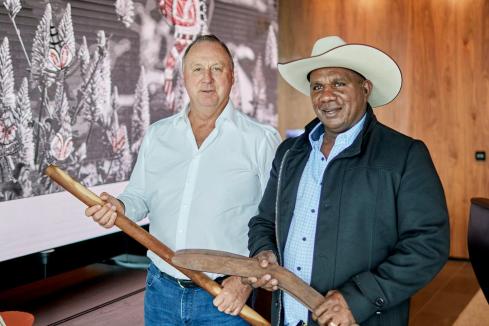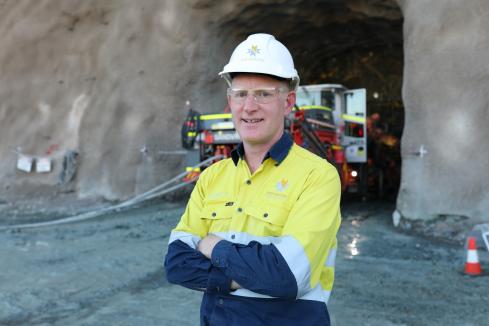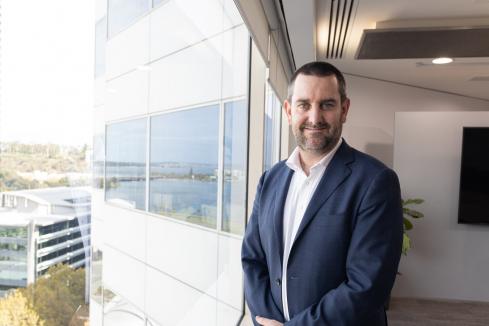The salt of the earth miner-turned reluctant dealmaker talks to Business News about the transaction that’s kept him, and the market, on the hook for more than a year.

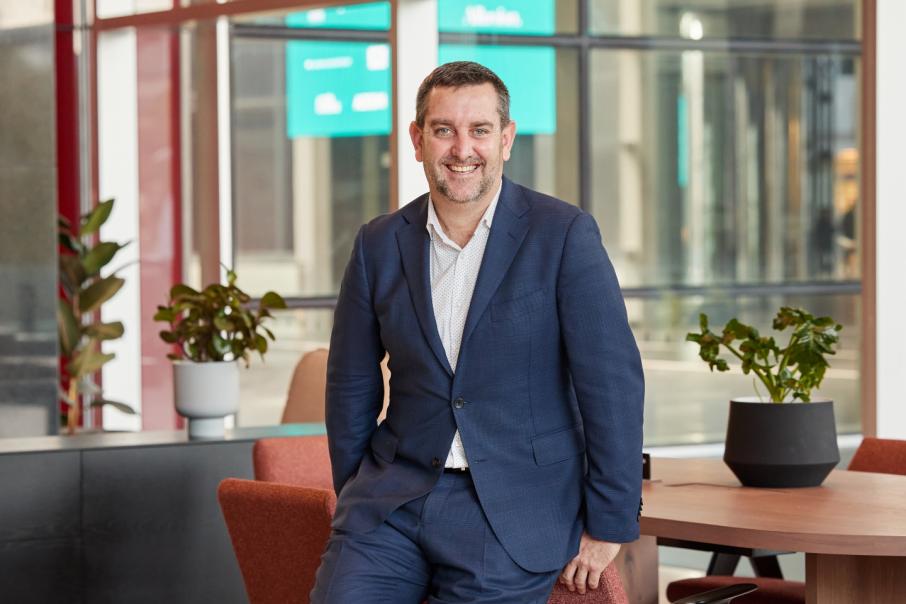
Raleigh Finlayson’s family history is steeped in the red dirt of Leonora.
At seven years old he recalls his uncles, Peter and Chris Lalor from Sons of Gwalia, used to stop by his family’s sheep station from the famed namesake mine on their way through to Kalgoorlie.
“I remember it vividly; they said, ‘if you can lift that gold bar out of the back of the boot of the car, you can keep it’,” he said.
“So, I’m there, seven years old, trying to lift this gold bar, which weighed as much as I did.”
Several decades on and the WA School of Mines graduate has clinched a deal to buy Gwalia, the mine run by his uncles and the one that gave him his first gig out of high school.
Mr Finlayson does not go so far as to call the deal a homecoming, but you can’t help but feel there’s a touch of it when hearing his long-standing family connections to the area.
His older sister, Marnie Finlayson, has shored up a successful career with senior operational roles with Rio Tinto and more recently taking up a director role at her sibling’s old haunt, Northern Star Resources.
The Goldfields native knew there would be twists and turns in crystallising his masterplan to consolidate Leonora, but nothing like the episode that played out.
He tells Business News the past 15 months have brought the biggest challenge of his career and, yes, were more stressful than buying half of the Kalgoorlie Super Pit.
“This deal has been by far and away the most consuming from a mental capacity,” Mr Finlayson said.
“If you had told me at the start it was going to take the 15 months, I might have wavered a bit, but at each juncture … it felt like we were closer.
“In hindsight, very early on, we were miles away.”
His success in growing Saracen Minerals as well as helping orchestrate the Northern Star Saracen mega merger, would have been enough for him to have rested on his laurels.
While his track record would indicate otherwise, there’s a seeming exhaustion when he talks about the “plotting” and the “trying to second guess” associated with getting a deal done.
He’s a man who wants to get in and run a mine, with the dealmaking a pleasantry he has to get out of the way first.
“I’d much rather fast forward to when that’s all done and then we’re just focusing on the execution part,” he said.
Dealmaker or operator, Mr Finlayson has garnered a reputation that precedes him.
The market was near elated in September 2021 by news he would be leading ASX-listed Genesis Minerals, his first big move since Northern Star.
“It’s never a good experience for me, because it’s almost like people are doing it on the promise about what could happen,” he said.
“I prefer the old way, where it’s more of a grind and no-one really pays too much attention.
“The more things go well, the more pressure that adds.
“In a bizarre sort of way, the expectation just keeps going up.”
Genesis’ leading asset is its Ulyssess deposit which, coincidentally, sits on land encroaching on Melita Station where his father and grandfather were raised.
He knows this area well.
It took less than four months into his new gig before rumours of grand plans to consolidate the region began to bubble, as Mr Finlayson began to stack Genesis with the old Saracen gang.
“Money follows people into stocks, which is completely different to what all of us experienced, frankly, on our first journey,” Mr Finlayson said.
“I think being able to access that funding, it’s good to be able to access that.
“But then it just amplifies the pressure … there comes expectation.”
Money has indeed followed him.
Over the course of the Leonora consolidation play, he’s managed to raise a total of $845 million, backed by the likes of Kerry Stokes’ Australian Capital Equity, Resource Capital Funds and Australian Super.
The first puzzle piece was Dacian Gold in July 2022, which had buckled under the weight of creeping cost pressures and announced it would be suspending operations at its flagship Mt Morgans mine.
It came as something of a headscratcher at the time, with most of the market still processing talks Genesis had been having with ASX-listed Gwalia miner, St Barbara.
“We had to pivot and get Dacian done because we realised that Dacian, particularly the Mt Morgans plant, was going to be one of the key value drivers,” he said.
“We were far more advanced with St Barbara before we went and did Dacian but we had to pivot and get that locked away, because if that [had gone] somewhere else … half of our strategy wouldn’t have worked.”
Of interest to the Genesis entourage was Dacian’s three million tonnes per annum processing plant in Laverton, an asset Mr Finlayson said was crucial to executing his longer-term plan to match mines to mills.
“It was a really good period to do M&A,” he said.
“We picked up the company for $120-odd million, which in the context of the plant, building would nearly be double that.”
In securing this infrastructure, Genesis in theory won’t have to fork out for a previously mooted and subsequently booted upgrade to St Barbara’s processing plant.
The Dacian vote has been locked in for the most part, aside from a handful of shareholders, who have not come to the Finlayson party.
“We still want to obviously get to the point where we ultimately own 100 per cent of Dacian,” he said.
“At the moment we’re at 80 per cent. That will be not a key priority, but something that we want to get sorted.”
In the months following Dacian, the market remained fascinated by the prospect of a transaction with the much larger St Barbara, which dwarfed its potential acquiror in terms of market capitalisation.
Mr Finlayson said the funding piece proved a key plank at this point in the puzzle, an element that more broadly went a long way in answering why he would ultimately be the one to tie assets in Leonora together.
“The obvious thing is St Barbara could have bought out Genesis,” he said.
“What it [St Barbara] would have not brought with it is an access to funding … that was why the deal had to get done from the St Barbara perspective.”
To outsiders, another catch was St Barbara’s Simberi and Atlantic assets in Papua New Guinea and Canada, respectively.
Both have presented their fair share of problems for St Barbara.
The solution to this was seemingly revealed in December 2022, when the pair divulged the shape of a long-speculated tie-up.
It was agreed St Barbara would shed its struggling overseas assets and list them as a new company on the ASX, called Phoenician Metals.
The Leonora assets would be held within new player, Hoover House.
“We had a very clear mandate … when we came into Genesis around sticking to WA,” Mr Finlayson said.
“So, we had to find a way to be able to separate them, which made the deal more complicated.”
But as the deadline drew close and, with conditions attached to the transaction still outstanding, the pair was back into negotiations at the start of April, before emerging with a new, recut deal.
The merger propositions would be shelved, and Genesis would walk away with Gwalia for $631 million in cash and scrip.
“The fact that we moved from that to an asset sale … didn’t overly surprise me,” Mr Finlayson said.
He could not say the same, however, for the arrival of a new bidder at the 11th hour.
Spanner in the works
Weeks after pinning down a restructured deal to acquire Gwalia, Murchison mid-tier company Silver Lake Resources came forward with an unexpected move: its own offer to buy St Barbara’s Leonora assets.
The $732 million cash and scrip proposal and subsequent public pushes were laden with claims the company had tried to engage St Barbara “several times” in the past 12 months to no avail.
What followed became a theatrical to and fro between Silver Lake and St Barbara, with the target’s chair, Kerry Gleeson, at one point lambasting Silver Lake via the ASX for demanding a “disruptive” two-week due diligence exercise.
Mr Finlayson said the whole dynamic flipped on its head.
“For ages it was us playing chess with St Barbara about which move to make and how they’d react to that and all that sort of dynamic,” he said.
“All of a sudden it was us and St Barbara on one side of the chessboard and Silver Lake on the other.”
Despite Silver Lake telling the ASX a major St Barbara shareholder had indicated it wanted to see the tilt progress to due diligence, Mr Finlayson told Business News in hindsight he still had faith in the support for Genesis’ offering.
“The fact that they [shareholders] were able to see that industrial logic of the deal … Silver Lake coming in was not going to bring any of the operational synergies to the area,” he said.
Work begins
With the Leonora board now set and both Dacian and Gwalia in hand, Genesis can start moving the pieces to grow to what it has promised to become: a 300,000 ounces per annum gold producer.
“People talked about ‘15 months and you finally got there’… the analogy I’ve been using is we crawled to the start line,” he said.
Asked whether Genesis might have overpaid for Gwalia, Mr Finlayson asserts that much of the market’s focus had been in the wrong place.
“There’s been so much focus on Gwalia, but the reality of it is one of the key projects we really like is actually the mine adjacent to Gwalia called Tower Hill, which is a 1.2 million ounce, open-pittable deposit right adjacent to Gwalia,” he said.
“What I love about the deal, is that in three years’ time when we bring Tower Hill on is, if I compare that to other open-pittable resources in WA at the moment, [it will be] a 1.2 million ounce open-pit resource at 1.8-gram head grade.
“It’ll be peerless when it gets to be started to mine.”
But will the market be willing to wait for results?
“If it were true dollars … then expectations would be a lot higher on us,” he said.
“We can busily in the background do our thing as we bring that closer and closer.
“The market’s not going to pay us for Tower Hill, they’ll pay us when we actually start to put a shovel into it, because we’ll be very forward about what that thing looks like over the course of the next five years.”
Developing Tower Hill will require relocation of a rail siding.
In talking about this, and true to form, the Kalgoorlie native sees this more as an opportunity hidden in plain sight, as opposed to an obstacle.
A more in-depth strategic plan for Genesis Minerals is in the works and due to be released in March 2024.






